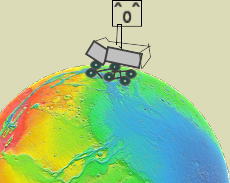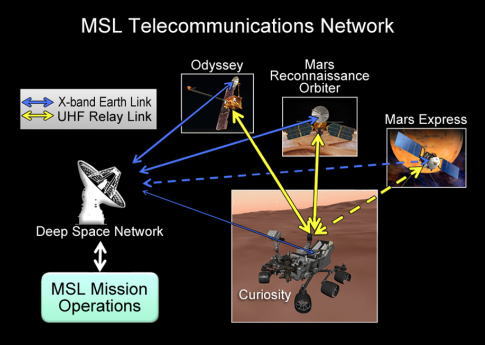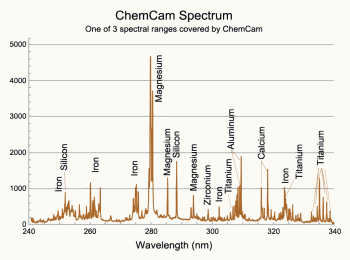文字サイズの変更: |小|中|大|
地球外生命体を探して
火星地表に現われた古代の河床を立証する円い小石礫岩の堆積層の画像をNASAが更新したのは、先週末のことだ。どのあたりかいえば、NASA公開の地形座標がわかりやすい。この続きは次の章で紹介します。
火星の極冠はドライアイスと砂とダストの層
火星の南北に極冠が発見されたのは17世紀、イタリア出身のフランス天文学者カッシーニによるもの。ずいぶん早くから発見されている。18世紀には火星も地球と同じような傾きがあることを知り、季節があることも発見。ドイツ出身の天文学者ハーシェルが発見した。火星の自転軸は地球とほぼ同じで、約25.2度ほど傾いている。南北の白い極冠はそれぞれ、夏になればドライアイスの氷の冠状が小さくなり、冬になれば大きくなる。マーズ・グローバル・サーベイヤーが撮影した渦巻状の白いシワシワの北極冠の画像(1999年3月)と、マーズ・リコネッサンス・オービターによる観測データの解析から、北極冠の地形は台地のように盛り上がっており、ドライアイスと砂とダストの層から出来ていることが判っている。火星の表面には現在水が見られなくても、過去に大量の水が流れて消えた痕跡から、極冠に渦状の氷と砂丘が残っているのは、実に神秘的と言えるかもしれない。
Curiosity Speaks Volumes
This chart shows increases in the volume of data coming back from NASA's
Mars rover Curiosity over recent sols, or Martian days. The rover has the
ability to talk directly to Earth, but its data can be relayed faster,
and in larger quantities, with the help of orbiters, including NASA's Mars
Reconnaissance Orbiter (MRO) and NASA's Odyssey.
New capabilities of the "Electra" relay-radios on MRO and Curiosity, including higher available data rates and a new capability in which the data rate is optimally varied throughout the relay pass, have greatly increased the volume of data the rover is sending back from Mars.
Image credit: NASA/JPL-Caltech |
|
 |
|
|
(2012/09/28) |
火星の部分日食
火星には2つの衛星があり、馬鈴薯のような、おイモさんの形をしたフォボス(Phobos)とダイモス(Deimos)という名前が付けられている。どちらもいびつな形だが、内側を公転している方がフォボスで外側を公転しているのがダイモス。フォボスの方が大きく27×22×18kmとのことで、ダイモスは15×12×10kmとのことだ。この9月19日にNASAの新しい火星ニュースが我々人類に届いた。キュリオシティがグレネルグ地域をマストカメラで岩や空を慌しく探査走行中、部分日食にも遭遇したとのこと。太陽の前を火星衛星フォボスが通過してゆく瞬間だ。NASAの研究グループによると、火星の衛星軌道にも火星内部に干潮満潮のような影響があるという。火星内部に生命体があるならば、それらにも僅かながら影響を与えているだろうとの見解。
| NASA Mars Rover Curiosity Looks at Ground Ahead, Moons Above |
|
| A series of daily drives has taken NASA's Mars Rover Curiosity to a vantage point about halfway to a science destination area called Glenelg. The rover has been using its Mast Camera to examine the area ahead and also to catch special occasions when the Martian moons Phobos and Deimos pass in front of the sun from the rover's point of view. |
On two recent days, Curiosity pointed the Mastcam at the sun and recorded
images of Mars' two moons, Phobos and Deimos, passing in front of the sun
from the rover's point of view. Results of these transit observations are
part of a long-term study of changes in the moons' orbits. NASA's twin
Mars Exploration Rovers, Spirit and Opportunity, which arrived at Mars
in 2004, also have observed solar transits by Mars' moons. Opportunity
is doing so again this week.
"Phobos is in an orbit very slowly getting closer to Mars, and Deimos is in
an orbit very slowly getting farther from Mars," said Curiosity's science team
co-investigator Mark Lemmon of Texas A&M University, College Station. "These
observations help us reduce uncertainty in calculations of the changes."
In Curiosity's observations of Phobos this week, the time when the edge of
the moon began overlapping the disc of the sun was predictable to within a few
seconds. Uncertainty in timing is because Mars' interior structure isn't fully
understood.
Phobos causes small changes to the shape of Mars in the same way Earth's moon
raises tides. The changes to Mars' shape depend on the Martian interior which,
in turn, cause Phobos' orbit to decay. Timing the orbital change more precisely
provides information about Mars' interior structure.
During Curiosity's two-year prime mission, researchers will use the rover's
10 science instruments to assess whether the selected field site inside Gale
Crater ever has offered environmental conditions favorable for microbial life.
For more about Curiosity, visit: http://www.nasa.gov/msl and http://mars.jpl.nasa.gov/msl . You can
follow the mission on Facebook and Twitter at: http://www.facebook.com/marscuriosity
and http://www.twitter.com/marscuriosity
.
Guy Webster / D.C. Agle
818-354-5011
Jet Propulsion Laboratory, Pasadena,Calif.
guy.webster@jpl.nasa.gov / agle@jpl.nasa.gov
Dwayne Brown
202-358-1726
NASA Headquarters, Washington
dwayne.c.brown@nasa.gov
|
| (2012/09/24) |
火星のミトコンドリア君
火星のゲイルクレーターは、NASA探査機マーズ・グローバル・サーベイヤー(1996-2007)がレーザー高度計によった作成した色分け高度地図を元に見ると、広大な北半球低地ユートピア平原のエリシウム山より南の方角エリシウム平原、南緯5.2度、東経137.3度の位置にある。探査車キュリオシティはこれから火星にいる地球外生命体との対面にわくわくしながら少しずつ走行し始めているのだけれども、火星のミトコンドリア君はすでに探査車を察知して、氷の層の下から地表に顔を出し地球のことも窺っているかもしれない。地球って、一体どんな惑星に観えているのだろう。
 |
 |
Color coding in this image of Mars represents differences in elevation,
measured by the Mars Orbiter Laser Altimeter on NASA's Mars Global Surveyor.
While surface liquid water is rare and ephermal on modern Mars, the topography
of Mars reveals large, ancient valley networks and outflow channels. These
are evidence that liquid water was more common and played a much more important
role in Mars' past.
Image Credit: NASA/JPL-Caltech |
3つのつむじ風
欧州金融危機
反日・尖閣領有
デフレスパイラルと原発事故レベル7の日本 |
|
(2012/09/18) |
ゲイルクレーター
火星探査車キュリオシティが着陸した場所はゲイルクレーター。生命体との対面の可能性が最も有利と考えられている理想的な場所だ。火星衛星オービターによる下図の色分け標高図面の白い矢印の指す円形部分だが、直径155kmと書いてある。中心にある青いマウントの外側の薄紫色内の平らな地点にキュリオシティは現在いる。標高差は5km余りのクレーターになるだろうか。火星には高さ27kmのオリンポス山もあるというから、地球感覚では地形が実感しない。一昨日、二酸化炭素のドライアイスの降雪を確認したニュースがNASAのWebサイトに詳しく記事にまとめられていたが、鉄分を多く含んだ赤い低地では強風や砂嵐もあるようで、-125℃の極寒や太陽からの強い放射線もあって、それらに耐え得るキュリオシティの地表移動測定能力も大したものといえる。
Gale Crater on Mars, where NASA's Curiosity rover is set to land, belongs to a family of large, very old craters shown here on this elevation map. It has one of the lowest elevations among this family.
The data come from the Mars Orbiter Laser Altimeter instrument on NASA's Mars Global Surveyor.
Image credit: NASA/JPL-Caltech |
|

 |
(2012/09/14)
3つの火星探査機
Water content (水の痕跡)を光の三原色で火星の土壌に表示しているのは、NASAが2001年に打ち上げた火星衛星マーズ・オデッセイからのデータ。今も火星を周回しており、バッテリーは太陽電池。地表に無事着陸した探査機キュリオシティとの連携で地球にデータ送信を行っている。他にも2つの火星衛星マーズ・リコネッサンス・オービター(NASA)と欧州宇宙機関(ESA)のマーズ・エクスプレスとも連携している。本格的な火星地表探査走行は、いわば人類の飽くなき宇宙大冒険の緊迫感あふれる壮大なミッションだ。MSLTelecommunications Networkの図表はこちら
|
人類の宇宙開発事業予算というものがどのくらいなものか、実に想像を絶する金額になるかと思われるが、人間の好奇心は理屈では説明しにくいもので、問題は人間のフィロソフィーにあると思われる。果てしない知識の渇望と、発見への渇望もあれば、飽くなき征服欲のようなものもあるだろう。根源のところでは、未知なるものへの計り知れない興味に尽きる。そのためなら命もかけ資金もかけるのが人間の習性だ。賢明なのか愚かなのか、あるいは希望とみえる幻覚なのか、夢を抱く生き物が人間なのであろう。他の動物や生物は決して夢などみない個体である。
問題なのは、人間の資金の使い方かもしれない。殺傷するための軍事兵器や国防費をかけるのと、宇宙開発事業にかけるのと、先進医療にかけるのと、バランスで考えるなら、生命体の星である地球のいのちと環境の浄化を優先して考えるべきではなかろうか。その上で天文学も成り立つような気がする。
|
|
 |
| The heritage for investigations with the Dynamic Albedo of Neutrons instrument on NASA's Curiosity rover comes from NASA's Odyssey orbiter. The orbiter has performed global mapping of neutrons, showing varying degrees of hydrogen in the Martian soil as indicated on this chart. The hydrogen is an indicator of the presence of water. |
Image credit: NASA/JPL-
Caltech/Russian Space Research Institute |
(2012/09/10)
そもそも火星はいったい誰のものか。早い者勝ち? 地球外生命体がもし見つかれば、「ここは我々の星だ。地球人の侵略は許さないぞ」とでも言いかねない。ただ、地球外生命体は当初より見つかったとしても微生物程度と思われている。地球のミトコンドリアに似た微生物でもいいから、ローバーが見つけてくれれば、「やあ、火星のミトコンドリア君、はじめまして。ボクの名前はキュリオシティ、キミは小さすぎてボクの電子顕微鏡でしか見えないけれど、火星を案内してくれないかい」とでも感動の対面ご挨拶をすべきかな。
 |
|
| This chart illustrates how NASA's Curiosity rover talks to Earth. While the rover can send direct messages, it communicates more efficiently with the help of spacecraft in orbit, including NASA's Odyssey and Mars Reconnaissance Orbiter, and the European Space Agency's Mars Express. NASA's Deep Space Network of antennae across the globe receive the transmissions, and send them to the Mars Science Laboratory mission operations center at NASA's Jet Propulsion Laboratory, Pasadena, Calif. |
| Image credit: NASA/JPL-Caltech |
| (2012/09/10) |
水にちかい液体の痕跡
いまNASAが熱い。今年8月6日に無事着陸した火星探査機キュリオシティから、火星の地表の画像や生成分などのデータが次々に送られて来ている。一つ一つがここまでリアルに伝わると、ひょっとして本当に水らしきものが見つかるかもしれない。水にちかい液体の痕跡が見つかれば、そこに火星の微生物か何かしらの化石も発見されるかもしれない。自走ロボット・ローバーこと「キュリオシティ」はこれから2年をかけて移動探査をする。動力源はプルトニウム238の崩壊熱を利用した原子力電池だ。地球外の宇宙でなら原子力も許容すべきか。
 |
 |
|
|
|
This image provides an example of the type of data collected by the Chemistry and Camera (ChemCam) instrument on the Mars Science Laboratory mission's Curiosity rover. The instrument uses a laser to generate a flash of ionized plasma on a target such as a rock, while observing the target with spectrometers receiving light through a telescope. Peaks in the intensity of light emitted at specific wavelengths are indicators of specific chemical elements in the target. |
|
Image Credit: NASA/JPL-Caltech/LANL |
(2012/08/31)
Navigator : 古川卓也
|